Driving digital transformation one touch at a time
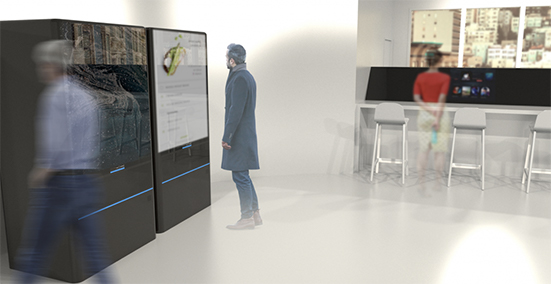
Driving digital transformation one touch at a time 3M Share Experientia gathered expert insights and voice of customer insights about intelligent self-service applications to create coherent storytelling for 3M clients and to provide compelling choices through predictive, engaging and learning touchpoints. We conducted a global benchmark research and interviews with industry experts to understand trends, changing paradigms and crucial concepts around intelligent self-service and created a B2B sales tool prototype: the innovation playbook that communicates the research outcomes. 3 things to know Global research Our benchmark focused extensively on Europe, US, China and Japan while industry experts joined our research from 5 different countries, bringing insights from all around the world. Driving digital transformation Design principles modelled empathic, people-centric frameworks for developing self-service experiences. Innovation playbook in action Future scenarios illustrate fast, intuitive, hassle-free experiences to end users who expect beauty and usability, familiarity and seamless connections. Gallery In depth Service mix: Design thinking Envisioning Business strategy design Information architecture Participatory design Service design Ethnography Context 3M offers a wide range of standard and customizable single-touch and multi-touch systems that are easy to integrate into OEM and display solutions, as well as a portfolio of fully integrated displays. This allows 3M clients to create interactive and immersive touchscreen experiences with systems and displays that are engineered for commercial applications and backed by advanced touch technology that’s ultra-fast, reliable and responsive. Challenge 3M reached out to Experientia to better understand its customers context and future scenarios that could strengthen its service offering. Research Experientia conducted a global benchmark research, collecting best practices and global innovative examples of self-service UX/UI systems, extracting relevant themes and trends. We interviewed 10 experts in architecture, design, food & beverage to gather first hand knowledge on how customer experiences are fueling innovation in the segment, and to understand trends, changing paradigms and crucial concepts around intelligent self-service. Design Experientia prioritized the interview insights using affinity mapping and constructed near-future scenarios analyzing different factors affecting UX. Ideation sessions generated new ideas to redefine how brands engage customers with intelligent self-service applications. Experientia designed a self service innovation playbook documenting research insights, design principles and scenario. It comes in a box containing the insights booklet, idea cards and impact map for co-creation, to aid collaborative design making. Impact The self service innovation playbook is now being used as a B2B sales tool to engage clients. Related projects All Services Behavioral design Research and assessment Strategy B2B Collaboration UI, redesigning the filter navigation experience B2B Reinventing customer and supplier interactions for a multinational flooring company B2B AR tools for industrial maintenance Go back to our portfolio
EZY Crowd Go, easy crowd guidance optimization
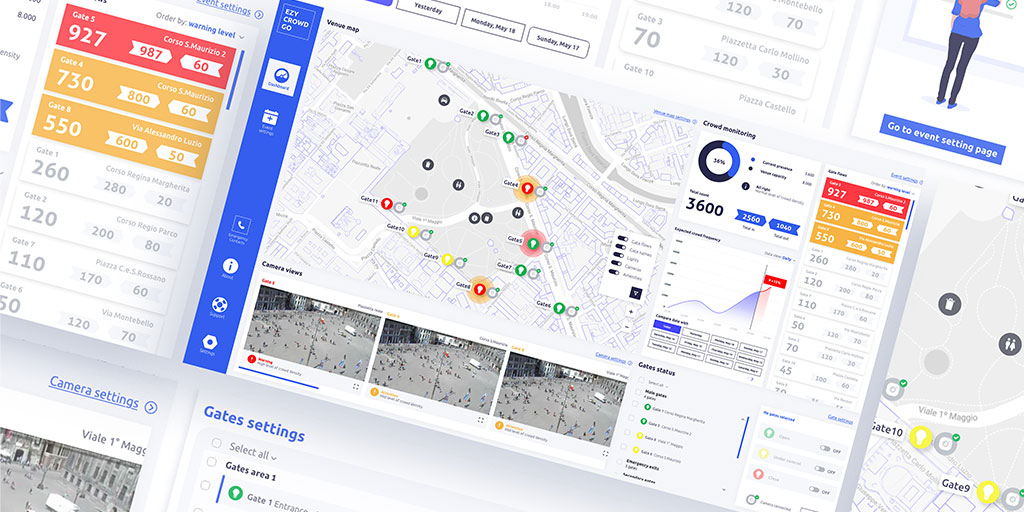
EZY Crowd Go, easy crowd guidance optimization EIT Digital Innovation Factory, European Research Project Share As a partner of the EZY – Crowd Go (an EIT funded project), Experientia co-designed wayfinding solutions to guide crowds during temporary events in public spaces. We conducted stakeholder research and led co-design activities with event managers and security professionals to identify new service opportunities, provide UX guidelines and design the prototype of the IoT dashboard. 3 things to know Clarify the needs and “jobs to be done” Investigate start-up MVP market interviewing stakeholders involved in the event management industry, to clarify needs, pain points and opportunities regarding the management and monitoring of crowds. Define the value proposition Using co-design methodology to identify a long term USP for safe exit strategies during temporary events. Future customers are both public authorities and private organizations that would benefit from using a system that guides event-goers to the least crowded exits. Design and validate the MVP solution Defining UX strategy and guidelines for visitor front-end exit guidance and designing a hi-fi dashboard prototype of the operational lights and sensors back-end IoT. Gallery In depth Service mix: Envisioning Prototyping Service design Context In the context of the European research project EIT (European Institute of Technology) Digital, Experientia co-designed wayfinding solutions to guide crowds during temporary events in public spaces. The IoT solution combines non-invasive WiFi crowd monitoring and crowd guidance directions using smart lights and sensors. Challenge During the initial and exploratory phase, we conducted stakeholder research and led co-design activities with event managers and security professionals to identify new service opportunities. During the design phase, we defined UX guidelines and designed a dashboard IoT prototype for security and facility managers to recommend behavior choices based on a data analysis of crowd-behavior. Research During the “early bird period” November-December 2019 Experientia research team conducted in-person and remote stakeholder interviews. The in-depth interviews allowed us to investigate the research question from a broad, comprehensive perspective. The main objective of the research was to investigate and identify opportunities for temporary event management. Model At the beginning of 2020 Experientia conducted a kick-off workshop with all the partners . We shared insights from the stakeholder and user research phase to inform and define the value proposition. Through participatory and co-design methodologies we facilitated the development of the next phases as well as conducted concept ideation activities. Design Experientia and the Polytechnic University of Milan used the findings from research to frame and define solutions for the design phase.In particular, we define the design guidelines for effective and inclusive crowd guidance and developed three innovative concept for addressing crowds during temporary events. Moreover, our interaction team design and validate the HI-fi prototype of the centralized dashboard, aim to collect crowd data and help operator make decisions and set the light system. Related projects All Services Behavioral design Research and assessment Strategy Cities & InfrastructureSocial innovation ToNite: social innovation and urban regeneration in Turin, Italy Social innovation Turin Public Libraries, redesigning the cultural experience Social innovation COE, Strengthening access to justice through non-judicial redress mechanisms Go back to our portfolio
CityOpt: Engaging citizens to facilitate energy demand responses
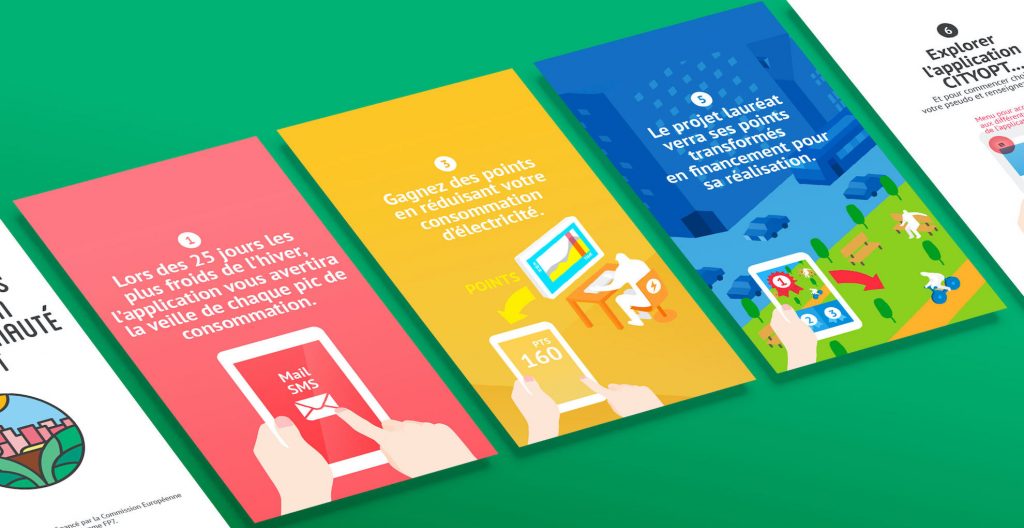
CityOpt: Engaging citizens to facilitate energy demand responses European Commission FP7 Share CityOpt, a research project funded under the FP7 European Commission framework, is getting citizens involved in testing new tools to reduce energy consumption during peak loads, with the goal that this pilot program will set a new trend in protecting locations with fragile electricity supplies. 3 things to know Encouraging behavioral change The CityOpt app helps people reduce domestic energy consumption during energy peak loads and nudges them towards more eco-friendly behaviors. Incentivizing energy reduction Their savings were rewarded with points, which participants could “donate” to a local community project of their choice, helping to maintain people’s engagement with the app. Real time monitoring An office block in Vienna, Austria, uses the CITYOPT app to identify the best scenario to integrate energy supply sources with fluctuating temperatures into an efficient micro-energy network.. Gallery In depth Service mix: Policy development Envisioning Business strategy design Prototyping Information architecture Participatory design Service design User experience testing Context One of France’s most fragile regions, the Provence-Alpes-Côte d’Azur, is perhaps best known for its vineyards, lavender groves and sparkling coastal cities like Nice. It is however also one of France’s most fragile regions for electricity supply. Particularly in winter, when electrical heating sees electricity use rise, the locals experience frequent blackouts, as the local energy provider, EDF, tries to manage the supply. This is why Nice Côte d’Azur has been selected as a pilot city for the CITYOPT project, an initiative that aims to create new methods and tools to deal with energy consumption, and to involve local citizens in designing and testing them. CITYOPT is a pilot programme funded by the European Commission that explores and tests new tools for reducing energy consumption during peak loads. Research Experientia has led the user research activities for the pilot program. User experience methodologies have engaged local citizens from the area in interviews, workshops and design activities. These have defined what people really need to help them control their energy use, and to create a mobile app that the pilot participants will be able to use to do just that. The entire project has applied a user experience (UX) methodology, to make sure that the tools and methods that the project proposes for energy management resonate with the people who will have to use them. It’s not just Nice Côte d’Azur: other pilots are planned for Helsinki, Finland and Vienna, Austria, where similar UX methods are also being applied. Right now, the Nice pilot looks at the residential level, and explores how people’s everyday behaviors can be nudged to better support the energy use of the entire region. Model Changing individual behaviors to help the entire region The Nice Côte d’Azur local population plays a crucial role in reducing domestic electricity consumption during peak loads. To help people change the way they consume electricity, the pilot provides selected locals with the CITYOPT mobile app (aka the CITYOPT Operational tool). The app informs people about upcoming network peak loads, and then uses playful persuasion to get them to commit to lowering their energy consumption at a specific time. How the app was created – a participatory process The Experientia design team also focused on the visual design of the mobile application. In workshops for design idea creation, designers and local stakeholders came together to brainstorm innovative ideas that could potentially be included in the app. A second participatory workshop, again involving local stakeholders, compared these ideas to the expectations and needs of local people, which had been uncovered in the original interviews and workshops with people from the region. The feasibility of the different ideas was discussed, and the final features for the CITYOPT app were selected. Designing, sketching and coding is a long road from ideas to app. First Experientia’s design team, with the support of the local project partners, worked on three wireframes of the app, which defined the information architecture and interaction model for how the app would work. Later on, colors and styles were added, taking it from outline to a fully-fledged design. Experientia then developed the front-end, web-based code, while the consortium partners – CSTB and EDF – implemented the back-end, repositories, hardware interfaces and statistical algorithms. Nice Côte d’Azur Métropole was responsible for localizing the application in French and recruiting local dwellers to participate in the pilot test. Impact The project was piloted with 200 households in Nice using the CITYOPT app during the first wave of testing. During the demonstration test, leader Experientia explored how people use the app, whether they take part in the demand-response scenarios, and what conditions and driving factors are most likely to convince people to participate. The test research was supported by quantitative and qualitative activities like online surveys, contextual interviews and contextual observations. The actual consumption data was also measured through pre-installed smart-meters, and used to evaluate the effectiveness of the CITYOPT system. The CITYOPT project has provided us with real data on effective ways to convince people to reduce their energy use at a level that can help improve the consumption of an entire region. It’s now a matter of scaling up the project to the entire region, and beyond, and providing a body of information that can be used by any region looking for effective ways to reduce energy use. Meanwhile, the other CITYOPT pilot programmes will demonstrate that Nice is not a solitary example, and that user experience methodology can offer real impact on people’s behaviors, and on behavioral change for more sustainable lifestyles. Related projects All Services Behavioral design Research and assessment Strategy Cities & InfrastructureSocial innovation ToNite: social innovation and urban regeneration in Turin, Italy Cities & InfrastructureSocial innovation Low2No: shaping the future of sustainable living Go back to our portfolio
Singapore: a city for people aging gracefully
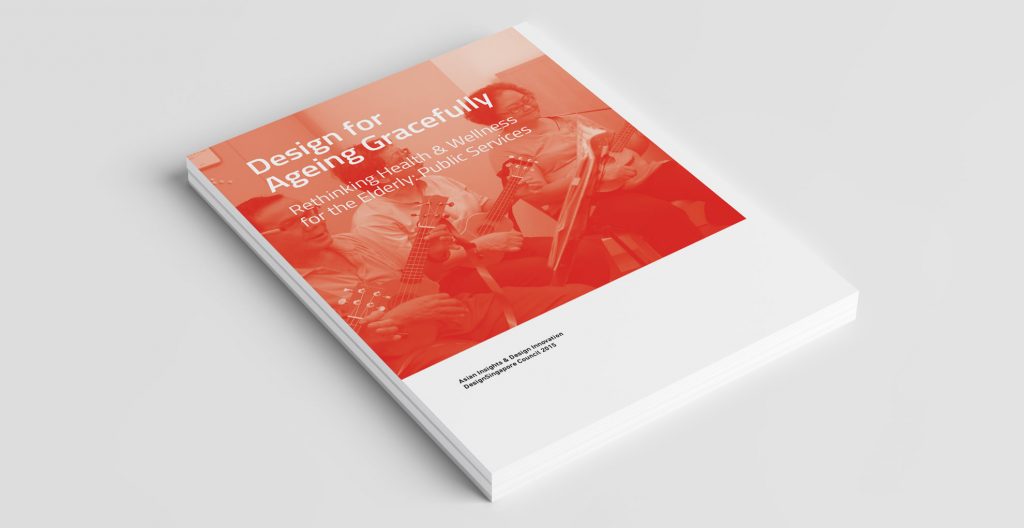
Singapore: a city for people aging gracefully DesignSingapore Council Share DesignSingapore Council asked Experientia to explore health and wellness for the elderly in the Singaporean public sector. We conducted ethnographic research and participatory design workshops, as part of a drive to develop design-led innovation for the health industry. 3 things to know Design ethnography and service design Experientia explored current healthcare experiences of the aging population in Singapore through design ethnography identify opportunities for design-driven innovation in public healthcare. We identified opportunity areas for design-driven innovation in the Singaporean public healthcare space to help Singapore create the right conditions to support a rapidly aging society. Interactive map of findings The interactive map allows people to browse the personas alongside field research videos, that communicate the research findings in the participants’ own words. Long lasting impact The findings have been incorporated in the Health Ministry’s ongoing Action Plan For Successful Ageing, and guided the development of a new residential impact. Gallery Singapore is proactively addressing the problems of a rapidly aging society We explored what is like to grow older in Singapore today, carrying out contextual interviews and shadowing with elderly people, their carers, and people with the healthcare industry. In participatory design workshops with Singaporean stakeholders, we introduced experience design guidelines and created concepts and strategies to improve the elderly healthcare system in Singapore. Our 8 personas show different experiences of aging and using the healthcare system in Singapore. Our customer journeys maps show the typical issues the participants experiences as they tried to manage their health. In depth Service mix: Design thinking Policy development Envisioning Participatory design Service design Behavioral modeling Ethnography Useful links: Download the pdf English language Website External link Singapore press External link Press release External link Press article External link Press article External link Context By 2030, Singapore will experience a profound shift in its age demographics with the elderly population increasing by three times. This calls for a radical change in perspective on how care can be better delivered to the elderly. Challenge To prepare and plan for that change, The DesignSingapore Council’s Asian Insights and Design Innovation (AIDI) programme embarked on a Rethinking Health and Wellness for the Elderly project to look into developing design solutions that better meet the needs of the elderly in Singapore, and asked Experientia to carry out an extensive research and analysis project , including a workshop with participating public agencies and services from the Singapore healthcare system. Research The project started with an understanding of global trends in elderly healthcare services. This was then followed by a design ethnography study through interviews and shadowing – to gather deep qualitative insights into the habits and behaviours of the elderly and to identify trends, behaviors and gaps in the interaction between elderly people and the healthcare system. From the observations, we learned about how the elderly think, act and feel towards managing their health at home and their needs and wants. Experientia developed 8 personas to begin the process of designing for behavioural change and explore solutions like ageing-in-place, peer-to-peer support and community platforms to solve some of the elderly healthcare issues. Participatory workshops allowed stakeholders from the public to be part of this process generating 12 main user-centred design concepts. In two multi-day innovation workshops with healthcare and public service stakeholders, representatives from the healthcare industry and public sector joined Experientia and DesignSingapore Council in Singapore. Here we introduced the challenges the participants face on a daily basis, showing video clips from the research to reveal the human faces behind the research. The stakeholders developed service concepts that would suit the unique characteristics of Singapore. Design Experientia team designed an interactive map of findings, a rich database resource that invites stakeholders to explore and be inspired to innovate and design relevant solutions for the ageing population. The concepts were useful to guide Singaporean healthcare agencies to create strategies, policies and services. The results of the project were compiled in a handy publication for further use in Singapore and freely available for anyone. As part of the project, Experientia also worked with Singaporean agencies and ministries to devise community-focused concepts for elderly residents in the Kampung Admiralty residential block. Co-creation workshops prototyped key policy decisions on ageing, health and housing. Impact Experientia’s report recommendations were widely reported in the Singapore press and were integrated in the Government’s $3billion Action Plan for Successful Ageing (website – pdf – press release – press article). The Kampung Admiralty residential block has been completed. It incorporated many of the concept ideas that were co-created in the Experientia-lead workshops. Download the pdf English language Website External link Singapore press External link Press release External link Press article External link Press article External link Related projects All Services Behavioral design Research and assessment Strategy Cities & InfrastructureSocial innovation ToNite: social innovation and urban regeneration in Turin, Italy Health GoCare: Interactive dashboard for a better home hospitalization service Health Rare disease patient journey mapping Go back to our portfolio
COE, Strengthening access to justice through non-judicial redress mechanisms
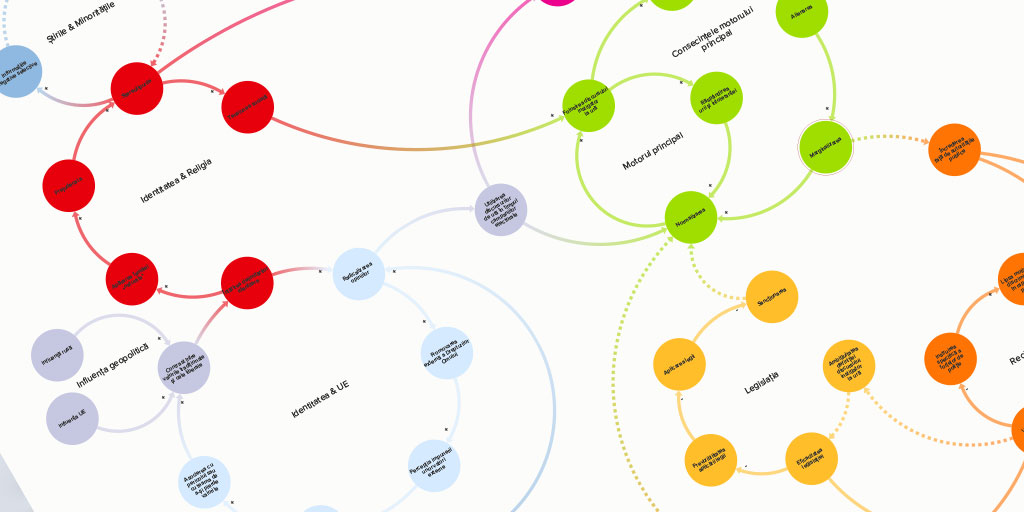
COE, Strengthening access to justice through non-judicial redress mechanisms Council of Europe Share In recent years, we have all become aware of the threat hate speech poses to human rights, democracy and the rule of law. Developing effective strategies to address it has become a major concern for national authorities and civil society actors across Europe. The Council of Europe selected Experientia to map the hate speech mechanisms within some EU countries. 3 things to know The importance of stakeholders Meeting the different stakeholders was essential to understand what were the commonly shared problematics and the specific ones related to each actor. The inclusion of stakeholders in a workshop to define the prioritary issues to overcome was essential, though many different perspectives. A new approach Through meetings with experts, desk research and readings, the team outlined some of the specific aspects and actors contributing to the current situation of hate speech, both in public and private contexts. The team developed a systemic map whose aim is to outline the main mechanisms and factors (and their interconnections) leading to hate speech countries. Future directions and policies The data gathered was useful to map some actions undertaken (mitigating or balancing factors) to prevent and combat hate speech, but also to grasp some early signals of potential future initiatives having an impact on Hate Speech. Gallery In depth Service mix: Envisioning Ethnography Context The Council of Europe selected Experientia to map the hate speech mechanisms within some EU countries. In recent years, awareness has been raised of the threat hate speech poses to human rights, democracy and the rule of law. Challenge Developing effective strategies to address it has become a major concern for national authorities and civil society actors across Europe. Such strategies should enable member states to significantly reduce the incidence and spread of hate speech, while respecting freedom of expression. Experientia mapped the hate speech mechanism and its involved variables through an extensive system map that helped to identify the gaps to fill in the legal framework, in the local services and in the collaboration between public authorities, citizens and politics in the countries that were part of the project. Research During the first phase of the project, Experientia collected and went through a number of documents and reports provided by the local consultants in each country: to build familiarity with the topic. The team went on with the Stakeholder Interviews and took part in a formative workshop session held by the Council of Europe. The stakeholder interviews allowed us to investigate the topic from different perspective and they helped to better detail the draft of the systemic map that was under definition. Design Experientia used the findings from the interviews and the documents to iterate the systemic map and write the systemic analysis report. In particular, we held two ideation workshop to create a space to define and agree upon potential opportunities and measures to be taken against the hate speech spreading and the leading institutions that will coordinate the development of such opportunities in the future. Related projects All Services Behavioral design Research and assessment Strategy Cities & InfrastructureSocial innovation ToNite: social innovation and urban regeneration in Turin, Italy Social innovation Turin Public Libraries, redesigning the cultural experience HealthSocial innovation Singapore: a city for people aging gracefully Go back to our portfolio
Buttonless: engaging users in interactions with keyless devices
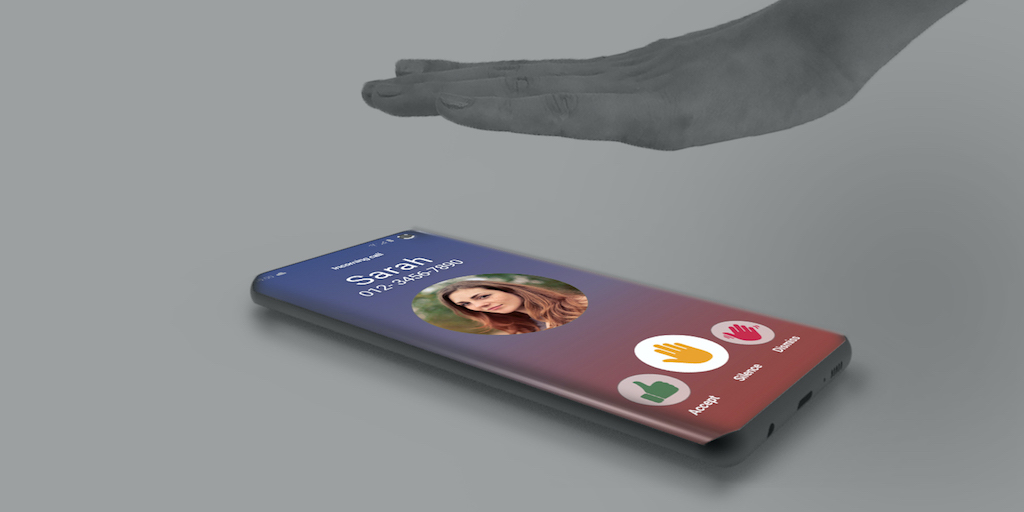
Buttonless: engaging users in interactions with keyless devices Samsung Share As we inch closer to phones with all-screen designs, physical buttons are on the chopping block. But how do you interact with a smartphone that has no buttons? Samsung asked Experientia to develop two navigation frameworks for a concept device. 3 things to know A new language Through extensive research, benchmarking, and the organization of a workshop with industry experts (incl. cognitive psychologists and UX specialists), a new language of interacting with a buttonless device was constructed, focusing not merely on isolated substitutes. From the workshop, two design challenges were identified and subsequently developed. The path to keyless strategy The strategy is based on analyzing the dynamic relationship between the user and the device, understanding that the device’s position significantly influences interaction (Edward T. Hall, ‘Proxemic’, 1968). By tracking user location and device handling, the device and its AI can anticipate user expectations and respond intelligently to various usage conditions. UX, UI and usability test The development of a functional physical prototype for a specific interaction was instrumental in augmenting the persuasiveness and efficacy of our design proposition. Moreover, Experientia conducted a usability test involving seven participants whose demographic characteristics aligned with potential international users of forthcoming Samsung flagship devices. This assessment centered on evaluating key aspects of the developed UX framework, thereby providing valuable insights into its usability and effectiveness. Gallery Benchmark Competitor Assessment Concept development Test User Test In depth Service mix: Envisioning Prototyping Information architecture User experience testing Useful links: Wired article External link Context Samsung, one of the world’s renowned communication companies, turned to Experientia to craft a tailored UX framework for the development of buttonless mobile solutions, encompassing both lateral and non-lateral interfaces. Challenge The task for Experientia was to cultivate a distinct language of interaction between users and their devices, fostering a seamless and intuitive user experience. Research The research process aimed to create user-centric UX navigation frameworks for buttonless devices. It started with market benchmarking and heuristic evaluations of alternative interaction methods, then an expert workshop identified key issues. Framework ideation led to tailored proposals, prototyped for validation. Design User testing gathered valuable insights, including changes in device handling under different conditions, universal gesture commands, and strategies for preventing user errors. This thorough research process informed the creation of user-centric UX navigation frameworks, ensuring a seamless and effective user experience. Impact The results of the project, center on establishing a symbiotic language between the device and the user. This language encompasses specific gestures and interaction cues designed to facilitate a seamless and harmonious collaboration between the user and the device, ultimately enhancing the overall user experience. Wired article External link Related projects All Services Behavioral design Research and assessment Strategy Brand UXConsumer technology European car aesthetics: Unveiling preferences and values Brand UXConsumer technology Mobile Privacy UX Consumer technology Customer experience insights to innovation Go back to our portfolio

